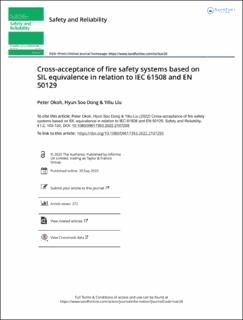| dc.contributor.author | Okoh, Peter | |
| dc.contributor.author | Dong, Hyunsoo | |
| dc.contributor.author | Liu, Yiliu | |
| dc.date.accessioned | 2023-01-04T11:22:19Z | |
| dc.date.available | 2023-01-04T11:22:19Z | |
| dc.date.created | 2023-01-02T15:32:37Z | |
| dc.date.issued | 2022 | |
| dc.identifier.citation | Safety and Reliability. 2022, 41 (2), 103-120. | en_US |
| dc.identifier.issn | 0961-7353 | |
| dc.identifier.uri | https://hdl.handle.net/11250/3040884 | |
| dc.description.abstract | Several sectors, e.g. process, railway, etc., have set their functional safety standards based on the generic IEC 61508. Yet, a product that is originally developed based on IEC 61508 is not automatically accepted for use in specific industries. Therefore, companies that are keen on selling safety products across sectors are faced with the challenge of satisfying the requirements sector by sector, thus incurring more cost and time to market. Cross-acceptance across industries is expected to solve this problem. However, an approach with a quantitative focus (e.g. in relation to SIL) has yet to be identified and validated. Demonstrating consistency and compatibility between cross-domain standards in relation to system safety is necessary for harmonising safety integrity claims. This paper applies the relationship between PFDavg and THR to cross-acceptance, establishing SIL equivalence as a basis for cross-acceptance, supporting this with data prioritisation and recommending it together with architectural constraints, systematic capability, the original safety case, a supplementary safety case (accounting for differences between the original and target standards provisions), and the original safety manuals (for COTS components and the whole system) as a framework for achieving both IEC 61508 (generic) and EN 50129 (railway) certification for a fire detection system. | en_US |
| dc.language.iso | eng | en_US |
| dc.publisher | Taylor & Francis Group | en_US |
| dc.rights | Attribution-NonCommercial-NoDerivatives 4.0 Internasjonal | * |
| dc.rights.uri | http://creativecommons.org/licenses/by-nc-nd/4.0/deed.no | * |
| dc.title | Cross-acceptance of fire safety systems based on SIL equivalence in relation to IEC 61508 and EN 50129 | en_US |
| dc.title.alternative | Cross-acceptance of fire safety systems based on SIL equivalence in relation to IEC 61508 and EN 50129 | en_US |
| dc.type | Peer reviewed | en_US |
| dc.type | Journal article | en_US |
| dc.description.version | publishedVersion | en_US |
| dc.source.pagenumber | 103-120 | en_US |
| dc.source.volume | 41 | en_US |
| dc.source.journal | Safety and Reliability | en_US |
| dc.source.issue | 2 | en_US |
| dc.identifier.doi | doi.org/10.1080/09617353.2022.2107255 | |
| dc.identifier.cristin | 2099014 | |
| cristin.ispublished | true | |
| cristin.fulltext | original | |
| cristin.qualitycode | 1 | |

